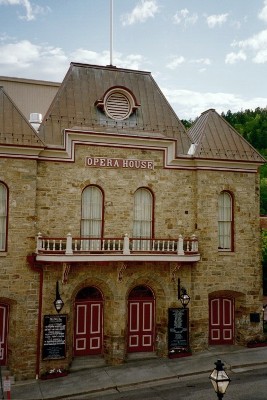Summer Opera 2006: The Ballad of Baby Doe
 Central City Opera House, opened in 1878 |
If there is a "house opera" at the Central City Opera House, it is certainly Douglas Moore's The Ballad of Baby Doe. Which makes sense, considering that the real-life action takes place in Leadville and the work was first presented in Central City in 1956. Unlike so many American operas, Moore's story has lost little of its charm since its premiere 50 years ago. There's plenty of drama - bordering on melodrama - but nothing too nasty or too complicated. The tunes are also easy to swallow.As Shulgold later reported (Central City Opera production hits jackpot with Horace No. 4, July 22) in the Rocky Mountain News, this production was plagued with one particular problem in the cast, going through four different baritones in the role of Horace Tabor:
There are weaknesses: The silver- vs.-gold thing gets old quickly, and Horace's final flashback scene is too long and heavy-handed (and here awkwardly staged). That said, it takes a hardened soul to be unmoved by the last scene: Snow gently falling around Baby Doe as she sings a hymn of devotion to her late husband. Who can resist the sheer likability of Baby Doe and its cast of actual turn-of-the-century Colorado characters? Not me. And not those who filled the Opera House on Saturday. Yes, we have seen a lot of this tale (it's been staged in '81, '88 and '96), but you can't blame the company for dusting off Michael Anania's sets (which replaced the originals by Donald Oenslager 10 years ago) and returning Baby Doe to the stage - particularly for its 50th anniversary.
Not that this year's version is a museum-piece display. Not with the superb cast that director Michael Ehrman was fortunate to inherit. The eternal triangle of Baby Doe and Horace and Augusta Tabor was brought to vivid life by Joanna Mongiardo, Timothy Noble and Joyce Castle. Under Ehrman's crisp direction, these three sailed over the occasional dips in the story and music.
Here's a future opera trivia question: Name the four Horace Tabors in the 2006 Central City Opera production of Moore's The Ballad of Baby Doe. Wholesale substitutions resulted from a throat ailment that finally forced Jake Gardner (Horace No. 1) to leave the show - but only after being replaced opening night by Timothy Noble (No. 2) and, after a brief run, by apprentice artist Jason Richard Plourde (No. 3), who subbed for 1 1/2 performances.
All this may seem to suggest a stretch of bad luck for the company - but, as we saw on Saturday, it led to an all-time lucky break for Central City Opera and its audiences. Enter Horace No. 4: Robert Orth.
Kyle MacMillan, Director comes around to "Baby Doe" charms (Denver Post, June 22) Keely Brown, 'Ballad of Baby Doe' provides a rarified experience (Summit Daily News, July 6) |
Director Michael Ehrman's production -- staged at the site of its world premiere a half-century ago, the company's 128-year-old opera house -- sparkles with costumes created by Ann Piano for his 2000 Utah Opera version and 11 extravagant sets designed by Michael Anania for CCO's 1996 revival. Douglas Moore's music and John Latouche's libretto are brilliant at times, particularly in "Willow Song" and the "Silver Aria" (which made a star of Beverly Sills in the 1958 New York City Opera production) and Augusta's showstopper "How can Can You Turn Away?" late in the second act. At other times the music and libretto are merely functional, serving the story's biographical and historical exigencies.Next summer, Central City Opera will increase its number of operas from three to four. I am going to try to get there in 2007, not least because I love the last opera on their schedule, Menotti's The Saint of Bleecker Street. CCO will also mount Verdi's La Traviata, the world premiere of Guo Wenjing's Poet Li Bai, and Massenet's Cendrillon. John Baril, a regular conductor at Central City, was appointed to the permanent post of Music Director this year, which will hopefully give the company a greater sense of musical stability.
The Tabors lived extravagantly, constructing a slew of public buildings in Leadville and throwing lavish parties from Denver to Washington, D.C., not to mention the regal jewelry that adorned Baby Doe. But with the demonetization of silver in 1893, they lost everything except the Matchless Mine, where Baby Doe was found frozen to death in a shack in 1935.





















































2 comments:
When will Menotti's operas receive the recognition they deserve? I can remember being particularly terrified by a performance of The Medium at the Edinburgh Festival in 1986 - Washington Opera I think it was, Beverley Evans in the title role..
Anon, I could not agree with you more. I am a big fan.
Post a Comment